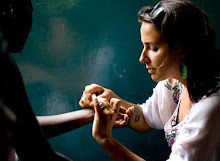So Fiona, Issac and I focused on squatting as a starting point for this assignment, as Fiona expressed interest in producing culture within a squat, Isaac interested in food, and I was interested in homelessness. After brainstorming for a while, we discussed important aspects of squatting in Amsterdam.
One thing we discussed, which I feel is a defining feature of squatting in Amsterdam is the sense of community and organization, the idea of togetherness, and free flow of information among squatters. I read an interesting article pertaining to this idea, "Is the Institutionalization of Urban Movements Inevitable? A Comparison of the Opportunities for Sustained Squatting in New York City and Amsterdam," by Hans Pruijt (2003) (I'm going to try to link this article). Squatters in NYC seemed to be much less organized and therefore lacking in community support in contrast with Amsterdam. We also felt that an important feature of the squatter's movement in Amsterdam is the anti-consumerism expressed, and the emphasis on doing-it-yourself: fixing, building, creating art, etc. Fiona's, second video on her blog post expresses this concept well. Other important aspects include the emphasis of organic (organic food) and knowing where things come from, making things and food themselves.
Anyway, we decided to form this research question, which of course, is subject to future provisions: How is anti-consumerism a cultural movement? And for our synechdoche, we decided on the De Peper Organic Cultural Kitchen. It is a legalized squat with inexpensive organic cuisine, performances, art gallery, and other cultural activities. Home to an anti-consumer subculture, and containing defining features of community, creation of culture, organic food and art, we felt De Peper would be a great stand in for the whole.
Monday, April 21, 2008
Wednesday, April 16, 2008
slight brain storms

So I have by no means thought these research topics through, but I'm just going to throw out some ideas. One I've been toying with since this thing started is something on graffiti, perhaps political graffiti. I haven't thought too much about this, I just happen to love graffiti.. I think it makes the world more interesting. I've also considered something to do with Amsterdam's perception of America.. I find it fascinating that the people of Amsterdam felt such a close affinity with America after 9/11 to the point that it had a great impact on Muslims in their country.
Something I've thought more about, however, is something I noticed that Haylee was also interested in (yay!): the way women are portrayed in various forms of media in Amsterdam. I've studied the portrayal of women in America somewhat, and I'm really interested in the over-sexualization, trivialization of women's power, and more subtle demeaning messages. A great documentary on this subject is Jean Kilbourne's "Killing Us Softly 3 (2000). Some of you may have seen this, if not you should check it out. I think the youtube version is split into four parts. I feel very strongly that the portrayal of women in the media should be studied extensively; advertisements are such a pervasive part of our society, and we are confronted with them constantly. These ads help to produce and reproduce gender roles and stereotypes.
I feel at this point I don't know enough about womens' status in Amsterdam to decide if this would be a good route to take. I would have to research such things as how women's pay stacks up to that of men's, women in government and other influential positions, and other not-so-quantifiable areas like expected norms and roles for women in marriage, family, etc.
If anyone else is interested in some of these things, holler at me :) rowe016@gmail.com
Monday, April 14, 2008
A walk in the park
So Emily, Fiona and I collaborated and we chose to observe greens or park type settings, mine being the New Haven Green, located in New Haven, CT, and theirs being Seattle Center. Let me start by saying that I like to call New Haven 'Connecticut's little NYC.' Its downtown area is trendy, with every type of food you could imagine, a great shopping district, bars and clubs. New Haven is also the home of three college campuses, including of course, Yale. The green is located in the heart of the downtown area, and hosts concerts on weekends. Think of it as a miniature Central Park to my miniature NYC.
Back to the collabo- being in completely different places and lack of "real life" (for lack of a better word) communication, we ended up researching different things.
I noticed many extremely interesting things on the emptier-than-usual green (I went early Sunday morning)- such as three churches surrounding the green - one of which was built over an old burial ground and still was home for a few gravestones (one was the first governor of "New Haven Colony" from 1657, and his tombstone read a haunting engraving:
"In a moment, in the twinkling of an eye
At the last trump the dead shall be raised.")
I also noticed a couple political messages in graffiti- one on a huge sculpture saying "STOP BUSH" which seemed to be rubbed out.
What I found most interesting, however, was although the green was almost empty when I went, there was a definite presence of a homeless population inhabiting it. This came apparent to me by using Jacobs' method of analyzing "clues." The clues provided by artifacts helped me explore my research question: "Is homelessness an issue in this area, and what is the community's response to the homeless?" I attempt to analyze some of these artifacts below.
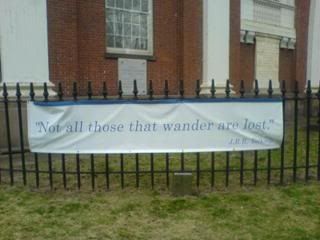
(1) This banner was hanging on the iron fence around one of the churches on the green. In case it is too small the quote says, "Not all those who wander are lost. -J.R.R. Tolken." Of course, this message could read in multiple ways. One of these messages could be primarily religiously concerned: meaning that people may be searching for meaning in their lives, and religion could be a way to find meaning. However, it could also be aimed at individuals that have fallen upon hard times, and the church might represent a beacon of hope for those people. I feel that this message was intended to be aimed at "wanderers" or the homeless who occupy this green. This sends a hopeful and welcoming message to those people.
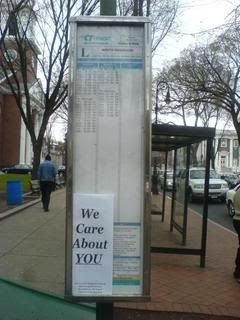
(2) There is a bus stop along the green's edge, and this is the schedule mounted into the sidewalk. At the bottom is a church pamphlet that reads, "WE CARE ABOUT YOU." While this pamphlet is probably intended for many audiences, this church is sending the message to the public that although they may feel hopeless or disconnected, there is someone right here on the green who will care about their problems.
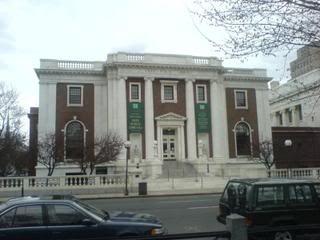
(3, 4) I'll discuss the above and below pictures together. Across the street from the green is the "FREE PUBLIC LIBRARY." This name may be insignificant, as most libraries are in fact free, but the fact that it is stated may be welcoming to the homeless. Below, however, is a sign on the door of the library asking people not to stand in the doorway or block the entrance. This is another indicator that there is a significant homeless presence in this area.

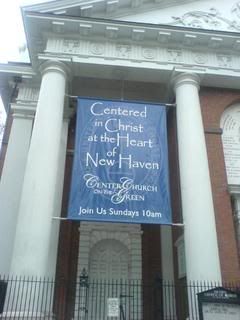
(5)This huge banner was hanging outside of one of the churches, Center Church on the Green, welcoming people to come and join their services. This was one of a few signs inviting people to join, and I feel that these churches made significant efforts to make people feel welcome and at home. Intended specifically and only for homeless people? No, but I do think it sends the message they are can seek refuge there.
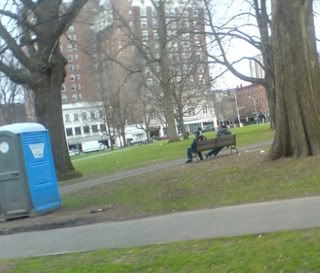
(6) I took this picture to show the two men sitting on the bench, as well at the porta-potty. Now, I don't assume that these men were homeless simply because they're sitting on a park bench early in the morning. However, there were many benches on the green and these men seemed to be comfortable and relaxed. The porta-potty indicates that there is obviously a need for a place for people to relieve themselves. This may be due to the fact that the green hosts concerts, but perhaps also to accomadate people hanging out on the green, and to prevent people from going to the bathroom anyway.
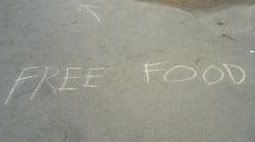
(7,8) Unfortunately, these two pictures were stubborn and wouldn't resize to display the whole thing. Written in chalk on a paved walkway on the green said "FREE FOOD EVERY SATURDAY 2:30" with arrows pointing in a direction. This was the most blatant clue as to the presence of homeless people on the green. It was also the most obvious clue that there is significant outreach to these people.
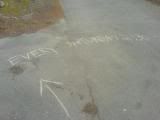
Conclusion:
While the artifacts on and around the green could be interpreted as clues in different ways, I came to the conclusion that there is a significant homeless population in this area. I also found that there seems to be a lot of outreach by the community, especially by the surrounding churches.
Let me say that this was much more fascinating than I expected. I realized how lax I am in my usual observations of my surrounding environment. You can actually learn a lot about a community, its demographics, its culture, etc. by simply looking around. Who woulda thunk it
Back to the collabo- being in completely different places and lack of "real life" (for lack of a better word) communication, we ended up researching different things.
I noticed many extremely interesting things on the emptier-than-usual green (I went early Sunday morning)- such as three churches surrounding the green - one of which was built over an old burial ground and still was home for a few gravestones (one was the first governor of "New Haven Colony" from 1657, and his tombstone read a haunting engraving:
"In a moment, in the twinkling of an eye
At the last trump the dead shall be raised.")
I also noticed a couple political messages in graffiti- one on a huge sculpture saying "STOP BUSH" which seemed to be rubbed out.
What I found most interesting, however, was although the green was almost empty when I went, there was a definite presence of a homeless population inhabiting it. This came apparent to me by using Jacobs' method of analyzing "clues." The clues provided by artifacts helped me explore my research question: "Is homelessness an issue in this area, and what is the community's response to the homeless?" I attempt to analyze some of these artifacts below.

(1) This banner was hanging on the iron fence around one of the churches on the green. In case it is too small the quote says, "Not all those who wander are lost. -J.R.R. Tolken." Of course, this message could read in multiple ways. One of these messages could be primarily religiously concerned: meaning that people may be searching for meaning in their lives, and religion could be a way to find meaning. However, it could also be aimed at individuals that have fallen upon hard times, and the church might represent a beacon of hope for those people. I feel that this message was intended to be aimed at "wanderers" or the homeless who occupy this green. This sends a hopeful and welcoming message to those people.

(2) There is a bus stop along the green's edge, and this is the schedule mounted into the sidewalk. At the bottom is a church pamphlet that reads, "WE CARE ABOUT YOU." While this pamphlet is probably intended for many audiences, this church is sending the message to the public that although they may feel hopeless or disconnected, there is someone right here on the green who will care about their problems.

(3, 4) I'll discuss the above and below pictures together. Across the street from the green is the "FREE PUBLIC LIBRARY." This name may be insignificant, as most libraries are in fact free, but the fact that it is stated may be welcoming to the homeless. Below, however, is a sign on the door of the library asking people not to stand in the doorway or block the entrance. This is another indicator that there is a significant homeless presence in this area.


(5)This huge banner was hanging outside of one of the churches, Center Church on the Green, welcoming people to come and join their services. This was one of a few signs inviting people to join, and I feel that these churches made significant efforts to make people feel welcome and at home. Intended specifically and only for homeless people? No, but I do think it sends the message they are can seek refuge there.

(6) I took this picture to show the two men sitting on the bench, as well at the porta-potty. Now, I don't assume that these men were homeless simply because they're sitting on a park bench early in the morning. However, there were many benches on the green and these men seemed to be comfortable and relaxed. The porta-potty indicates that there is obviously a need for a place for people to relieve themselves. This may be due to the fact that the green hosts concerts, but perhaps also to accomadate people hanging out on the green, and to prevent people from going to the bathroom anyway.

(7,8) Unfortunately, these two pictures were stubborn and wouldn't resize to display the whole thing. Written in chalk on a paved walkway on the green said "FREE FOOD EVERY SATURDAY 2:30" with arrows pointing in a direction. This was the most blatant clue as to the presence of homeless people on the green. It was also the most obvious clue that there is significant outreach to these people.

Conclusion:
While the artifacts on and around the green could be interpreted as clues in different ways, I came to the conclusion that there is a significant homeless population in this area. I also found that there seems to be a lot of outreach by the community, especially by the surrounding churches.
Let me say that this was much more fascinating than I expected. I realized how lax I am in my usual observations of my surrounding environment. You can actually learn a lot about a community, its demographics, its culture, etc. by simply looking around. Who woulda thunk it
Wednesday, April 9, 2008
There is no truth, only perceptions.
To explain the title of this blog, it comes to mind because I on the podcast, the speaker said something along these lines when telling the history of the Netherlands. But the idea that there is no ultimate reality, no Great Story, no absolute truth, is something I have come to believe more and more throughout my college years.
I find this idea especially fitting after viewing Submission (I'm going to stick to discussing Submission rather than Fitna to narrow my scope a bit). It is really fascinating for me to see these films and to read Murder in Amsterdam, which give an overall negative view of Islam -- because I am also taking a class Contemporary Cultures of the Middle East, and everything we read and learn gives a view that is quite opposite.
To be honest, I am perplexed by Islam. On the one hand, I read accounts from Muslim women who argue that veiling is not an act of obedience to men, but a practical way to navigate public, to protect the intimacy between husband and wife; modern or "new" veiling is also, by many accounts, the lifestyle choice made by college-educated urban women. I also have read that working is not desirable to many Muslim women, as they point out how Western women are exploited with lesser pay and a second shift at home. And while family-arranged marriages are still practiced, women increasingly are choosing their own husbands. And there is Submission. This woman tells the story of a forced marriage, being ripped from her lover, beaten by her husband who disgusts her, and raped by a family member. She is trapped behind her veil, barred from seeing the world and pursuing her dreams.
There is also the view that, yes, Muslim societies oppress women, but this is not rooted in Islam. It is a major argument that in the Golden Age of Islam, men and women were equal, and that this oppression results from the misinterpretation and manipulation of the Quran by men to justify and maintain a patriarchal society. Therefore it is not Islam the religion, that is inherently sexist and hateful (and as argued by some Dutch people, incompatible with their tolerant culture). In fact, one quote from the book, Peoples and Cultures of the Middle East by Daniel G. Bates and Amal Rassam, has been lingering in my mind since I read it:
"Just as Christianity is not invoked to explain features of Western societies, such as colonialism, racism, and the Holocaust, Islam likewise cannot be considered as determining all the characteristics of societies in the Middle East."
These are but a few different perceptions of Islam and its oppression of women. How can one possibly come to a conclusion as to what the "true story" really is? Are Muslim women being oppressed to the point of suffocation, and in need of some intervention, or is this "saving" simply a new form of colonial feminism?
My reaction, in sum, is just... I don't know.
I find this idea especially fitting after viewing Submission (I'm going to stick to discussing Submission rather than Fitna to narrow my scope a bit). It is really fascinating for me to see these films and to read Murder in Amsterdam, which give an overall negative view of Islam -- because I am also taking a class Contemporary Cultures of the Middle East, and everything we read and learn gives a view that is quite opposite.
To be honest, I am perplexed by Islam. On the one hand, I read accounts from Muslim women who argue that veiling is not an act of obedience to men, but a practical way to navigate public, to protect the intimacy between husband and wife; modern or "new" veiling is also, by many accounts, the lifestyle choice made by college-educated urban women. I also have read that working is not desirable to many Muslim women, as they point out how Western women are exploited with lesser pay and a second shift at home. And while family-arranged marriages are still practiced, women increasingly are choosing their own husbands. And there is Submission. This woman tells the story of a forced marriage, being ripped from her lover, beaten by her husband who disgusts her, and raped by a family member. She is trapped behind her veil, barred from seeing the world and pursuing her dreams.
There is also the view that, yes, Muslim societies oppress women, but this is not rooted in Islam. It is a major argument that in the Golden Age of Islam, men and women were equal, and that this oppression results from the misinterpretation and manipulation of the Quran by men to justify and maintain a patriarchal society. Therefore it is not Islam the religion, that is inherently sexist and hateful (and as argued by some Dutch people, incompatible with their tolerant culture). In fact, one quote from the book, Peoples and Cultures of the Middle East by Daniel G. Bates and Amal Rassam, has been lingering in my mind since I read it:
"Just as Christianity is not invoked to explain features of Western societies, such as colonialism, racism, and the Holocaust, Islam likewise cannot be considered as determining all the characteristics of societies in the Middle East."
These are but a few different perceptions of Islam and its oppression of women. How can one possibly come to a conclusion as to what the "true story" really is? Are Muslim women being oppressed to the point of suffocation, and in need of some intervention, or is this "saving" simply a new form of colonial feminism?
My reaction, in sum, is just... I don't know.
Monday, April 7, 2008
Toto, I don't think we're in Kansas anymore...
So I decided to check out Jana's blog from 2007, for the sole reason that her name brings back fond memories of childhood (Jana is a nickname my mom calls me). Anyway, let me start off with a disclaimer: I am COMPLETELY new to blogging... I wouldn't call myself a dinosaur but I'm not especially computer/internet/any king of technology-savvy. This is my very first blog. So you might call me a foreigner to this medium. But I, like Lynch notes, attempt to to perceive this environment in some ordered patter, though as a newcomer I may not pick up on the nuances and specific details that a "native blogger" might.
Like all other blogs, at least those on blogger.com as far as I know, the blog posts appear ordering from the most recent at the top, and at the very bottom is the oldest.... well the oldest unless you click on "Older posts." To the left (which is the opposite of my blog), is a picture of Jana, and below are links ordering blog posts from year and month. At the bottom, there is a link to an "about me" section. This main page isn't exactly comfortable for me, there is something about it that makes me uneasy-- not Jana's blog in particular, but all of these blogs in general. My preconceptions (probably because my social networking consists of Facebook, and in the past Myspace) would lead me to expect the main page to consist of primarily getting to know the blogger, with a picture being a main focus and other basic personal information... then providing links to specific blogs. Somehow I find it troublesome that there are long blogs one after another, scrolling scrolling scrolling. Well, those are just my initial feelings.. which I'm sure will dissipate with exposure, just like anything else.
Enough about me... let me try and explain how I think Jana dealt with this bloggy environment. The most recent blog post at the top had been her first update in a while. Hence the title, "Update." This one dated Aug 16, and the most recent one before this was May 21. Of course, a lot of time has passed and I'm sure a lot has gone on- since this most recent one is taking place in Amsterdam. Jana tries to compensate for this passage of time, but realizes way too much has gone on to touch on everything. She separates paragraphs by first discussing how she has changed her project topic.. then describing the social scene... then briefly describing Vienna. Jana tries to create order out of all of her thoughts and events she feels she should record, which I know seems like an impossible task once so much time has passed, and she does this by structuring her blog so that each paragraph can deal with one specific theme.
Jana creates order in her other posts, and is understood easily because she uses socially constructed norms of utilizing space. In one post, she records an interview, first providing the setting and description of the interviewee. Then she records the interview by Q and A, for example:
Q: How are you today?
A: Dandy.
This is a common way to record interviews, although frequently Q & A would be replaced with the interviewer's and interviewee's names. To most of us, this seems to give an interview more validity, rather than paraphrasing or summarizing in paragraphs. This structure is supposed to transmit the exact words of the interview.
Another post is made specifically to discuss problems that have arisen in the research topic. Jana lays out each problem in numbered paragraphs. This is much more easily absorbed and understandable -- I specifically chose this one to discuss because others that were structured in long paragraphs, one after another, seemed much harder to digest. I also find it interesting to note that this post with easily comprehensible structure and order is discussing ways in which aspects of her research project have been dismantled. I find that I use organization to alleviate anxiety that I am experiencing with projects or paper. Perhaps I feel that an orderly structure of an outline or proposal will result in everything falling into place and working out right. Maybe Jana felt the same way...?
Like all other blogs, at least those on blogger.com as far as I know, the blog posts appear ordering from the most recent at the top, and at the very bottom is the oldest.... well the oldest unless you click on "Older posts." To the left (which is the opposite of my blog), is a picture of Jana, and below are links ordering blog posts from year and month. At the bottom, there is a link to an "about me" section. This main page isn't exactly comfortable for me, there is something about it that makes me uneasy-- not Jana's blog in particular, but all of these blogs in general. My preconceptions (probably because my social networking consists of Facebook, and in the past Myspace) would lead me to expect the main page to consist of primarily getting to know the blogger, with a picture being a main focus and other basic personal information... then providing links to specific blogs. Somehow I find it troublesome that there are long blogs one after another, scrolling scrolling scrolling. Well, those are just my initial feelings.. which I'm sure will dissipate with exposure, just like anything else.
Enough about me... let me try and explain how I think Jana dealt with this bloggy environment. The most recent blog post at the top had been her first update in a while. Hence the title, "Update." This one dated Aug 16, and the most recent one before this was May 21. Of course, a lot of time has passed and I'm sure a lot has gone on- since this most recent one is taking place in Amsterdam. Jana tries to compensate for this passage of time, but realizes way too much has gone on to touch on everything. She separates paragraphs by first discussing how she has changed her project topic.. then describing the social scene... then briefly describing Vienna. Jana tries to create order out of all of her thoughts and events she feels she should record, which I know seems like an impossible task once so much time has passed, and she does this by structuring her blog so that each paragraph can deal with one specific theme.
Jana creates order in her other posts, and is understood easily because she uses socially constructed norms of utilizing space. In one post, she records an interview, first providing the setting and description of the interviewee. Then she records the interview by Q and A, for example:
Q: How are you today?
A: Dandy.
This is a common way to record interviews, although frequently Q & A would be replaced with the interviewer's and interviewee's names. To most of us, this seems to give an interview more validity, rather than paraphrasing or summarizing in paragraphs. This structure is supposed to transmit the exact words of the interview.
Another post is made specifically to discuss problems that have arisen in the research topic. Jana lays out each problem in numbered paragraphs. This is much more easily absorbed and understandable -- I specifically chose this one to discuss because others that were structured in long paragraphs, one after another, seemed much harder to digest. I also find it interesting to note that this post with easily comprehensible structure and order is discussing ways in which aspects of her research project have been dismantled. I find that I use organization to alleviate anxiety that I am experiencing with projects or paper. Perhaps I feel that an orderly structure of an outline or proposal will result in everything falling into place and working out right. Maybe Jana felt the same way...?
Wednesday, April 2, 2008
cloooooooooose reading :-0
This email is from a name I do not recognize, but the address ends in ".BarackObama.com" so I know it will be asking me to make a donation to the campaign. The subject is "Barack needs your help in Pennsylvania"... This subject says a lot. First, I get the impression that the writer wants to make a personal connection with me by using the word "your." Barack needs my help. Secondly, the writer wants to make me feel that I am powerful, by telling me that Barack needs my help. According to this writer, I have the opportunity to make an impact for Barack Obama. This phrase "needs my help," puts me in a dominant position because I have something that Barack needs. By using "Barack" rather than Obama or Barack Obama, the writer intends to make the candidate seem more personalable and accessibile, because we refer to our friends by their first names, and we use last names for people in positions of authority or for public figures or people that are otherwise very distant to us.
The first thing I notice about the body of the email is that the font is slightly bigger than usual, and this gives it a slight feel of advertisement, and for me makes it less personal. However, they address me by saying "Dear Cassandra," again to make me feel as if they have a personal connection with me. The first sentence of the body says, "In the past few weeks, thousands of people from all across the country have traveled to Pennsylvania to help grow our movement." This line is meant is meant to emphasize the strength of supporters of the Obama campaign, and to also create a feeling of solidarity among the supporters and myself by saying "our movement."
To paraphrase, the next paragraph says that the campaign has registered thousands of new Democrats that will help Barack win the primary, thanks to voters like me. This paragraph is again intended to make me feel special, in letting me know that I had a hand in Barack's future success. After this paragraph of praise, there is a separation from the next sentence which says, "Now we need to make sure all these new voices are heard." I feel that the separation of this sentence creates a sobering effect from the thanks and praise of the former. This sentence kind of says, "However, we still have business to take care of."
The next paragraph asks me to take a trip to Pennsylvania and help "Get Out the Vote for Barack:" The fact that the first letters of these last few words are capitalized give me the sense that this is some kind of slogan. The colon informs me that they are going to provide me a means to sign up for this trip, which they do, with a link below. This past paragraph also informs me that I was wrong about my first assumption that this email would be asking for campaign donations.
The next line says that the campaign has always relied on grassroots supporters to spread their word. This again, gives a personal touch, says that the individual, ordinary person can make a difference. I feel it's necessary to include the next paragraph: "The steps that we're taking right now will help us do more than win an election -- they will empower ordinary Americans to join with their friends, family, and neighbors in believing that together we can make a difference." This paragraph gives at once empowerment of the individual and the campaign, as well as patriotism and unity as the writer joins together "friends, family, and neighbors." This instills a sense that I can be part of a meaningful movement, an agent of change.
In the next paragraph, in bold letters, says: "No prior political experience is necessary." The writer says all you need is enthusiasm. The fact that the sentence is bold, of course, emphasizes its importance. It lets the reader know that this campaign is accepting, accessible, and wants to put you at ease that your support is welcomed, no matter what your experience. I am thanked again for my support, and the same link is provided again. This repetition emphasizes the importance that I sign up. The writer gives her name and position, and the email closes with "Paid for by Obama for America" with an icon that I can't make out. The "paid for.." lets me know this is an official email from the Obama campaign, and the icon just reminds me that my email doesn't properly reduce pixels of images.
Well, that was certainly longer than I expected.
The first thing I notice about the body of the email is that the font is slightly bigger than usual, and this gives it a slight feel of advertisement, and for me makes it less personal. However, they address me by saying "Dear Cassandra," again to make me feel as if they have a personal connection with me. The first sentence of the body says, "In the past few weeks, thousands of people from all across the country have traveled to Pennsylvania to help grow our movement." This line is meant is meant to emphasize the strength of supporters of the Obama campaign, and to also create a feeling of solidarity among the supporters and myself by saying "our movement."
To paraphrase, the next paragraph says that the campaign has registered thousands of new Democrats that will help Barack win the primary, thanks to voters like me. This paragraph is again intended to make me feel special, in letting me know that I had a hand in Barack's future success. After this paragraph of praise, there is a separation from the next sentence which says, "Now we need to make sure all these new voices are heard." I feel that the separation of this sentence creates a sobering effect from the thanks and praise of the former. This sentence kind of says, "However, we still have business to take care of."
The next paragraph asks me to take a trip to Pennsylvania and help "Get Out the Vote for Barack:" The fact that the first letters of these last few words are capitalized give me the sense that this is some kind of slogan. The colon informs me that they are going to provide me a means to sign up for this trip, which they do, with a link below. This past paragraph also informs me that I was wrong about my first assumption that this email would be asking for campaign donations.
The next line says that the campaign has always relied on grassroots supporters to spread their word. This again, gives a personal touch, says that the individual, ordinary person can make a difference. I feel it's necessary to include the next paragraph: "The steps that we're taking right now will help us do more than win an election -- they will empower ordinary Americans to join with their friends, family, and neighbors in believing that together we can make a difference." This paragraph gives at once empowerment of the individual and the campaign, as well as patriotism and unity as the writer joins together "friends, family, and neighbors." This instills a sense that I can be part of a meaningful movement, an agent of change.
In the next paragraph, in bold letters, says: "No prior political experience is necessary." The writer says all you need is enthusiasm. The fact that the sentence is bold, of course, emphasizes its importance. It lets the reader know that this campaign is accepting, accessible, and wants to put you at ease that your support is welcomed, no matter what your experience. I am thanked again for my support, and the same link is provided again. This repetition emphasizes the importance that I sign up. The writer gives her name and position, and the email closes with "Paid for by Obama for America" with an icon that I can't make out. The "paid for.." lets me know this is an official email from the Obama campaign, and the icon just reminds me that my email doesn't properly reduce pixels of images.
Well, that was certainly longer than I expected.
Subscribe to:
Posts (Atom)
